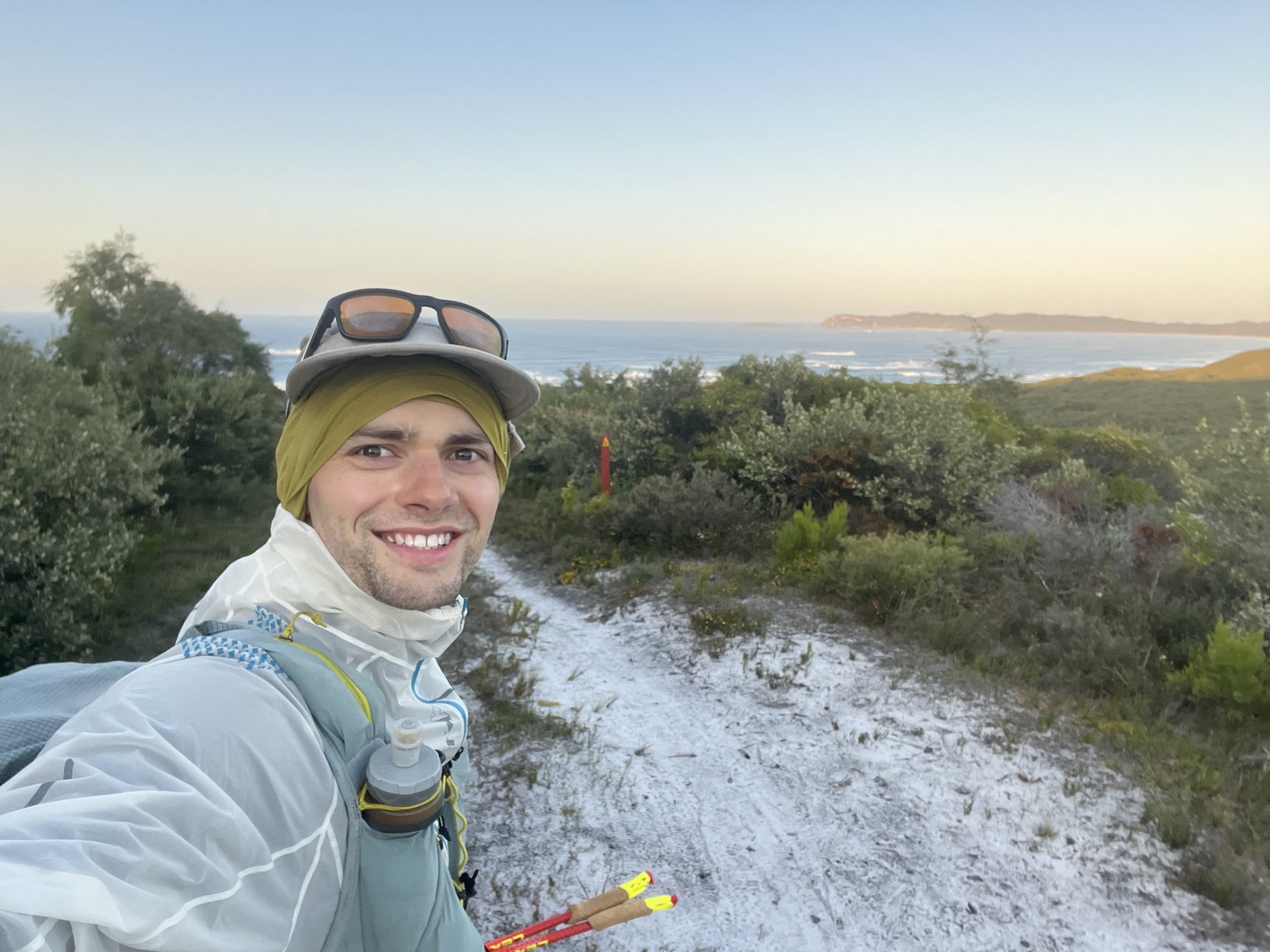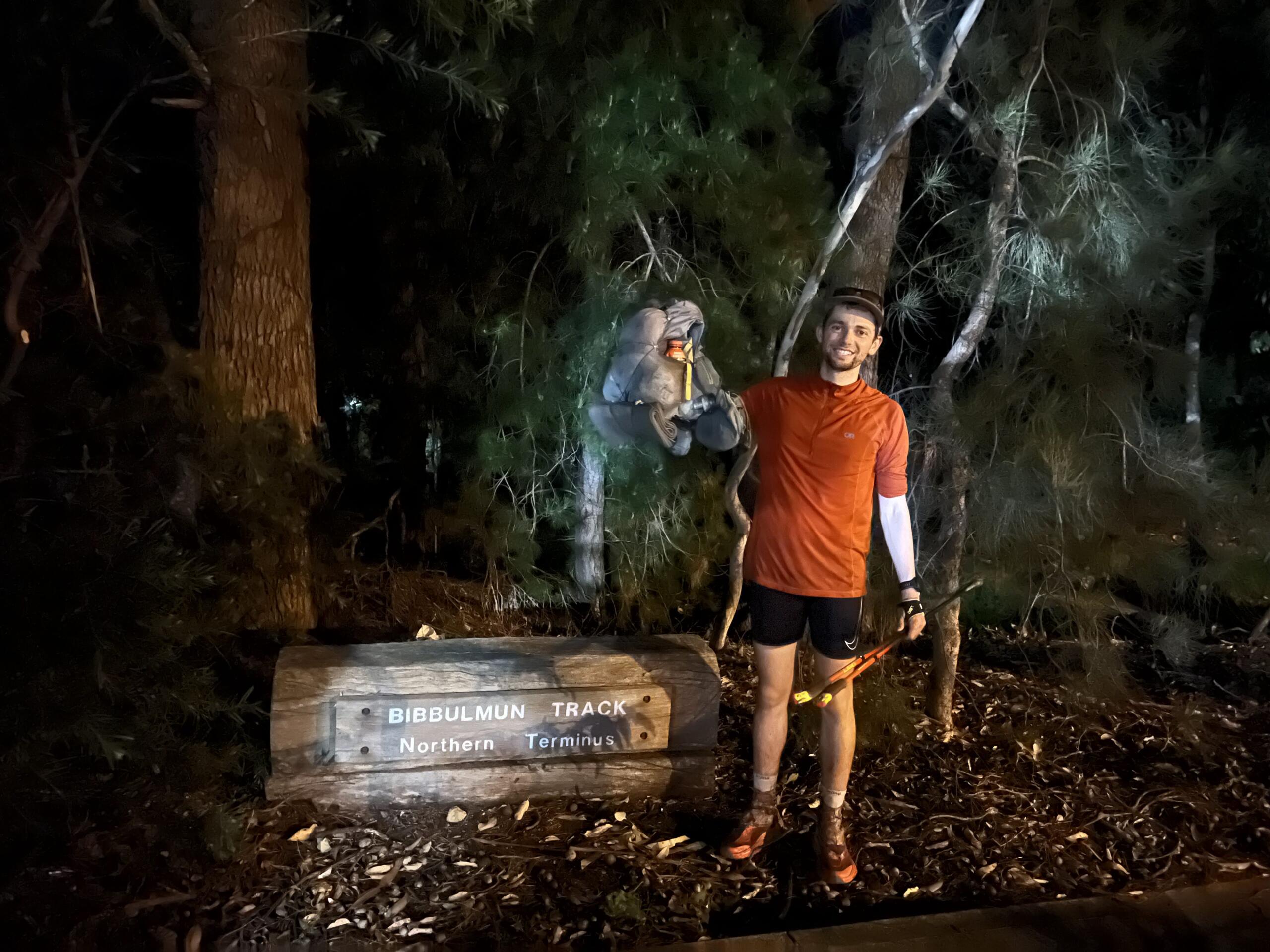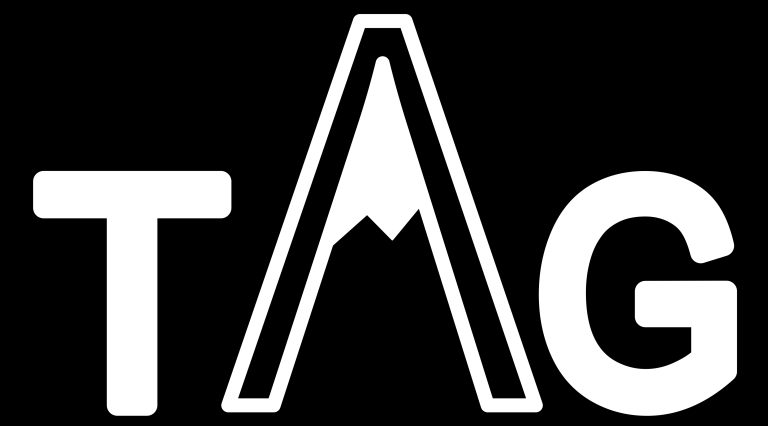Bibbulmun Track FKT Gear List (2.4kg/5.2lb) & Analysis
In September 2022, I (Tom Bartlett) set the self-supported FKT for the Bibbulmun Track hiking ~950km in 11 days 22 hours. The guidelines distinguishing between supported, self-supported and unsupported FKTs can be found here.
In the months leading up to the FKT attempt, Maddie and I hiked the 4300km long Pacific Crest Trail. Nearly every day whilst walking I found my mind drifting off to consider what gear I would use for a hypothetical Bibbulmun speed attempt. Maddie put up with many hours of discussion and deliberation over endless details and this gear list is the result. After the list I discuss important gear choices highlighting changes made since the AAWT FKT.
Total weight in list: 3385g/119.40oz
Worn weight: 1014g/35.77oz
Base weight: 2371g/5.23lb
Sleeping
| Item | Product | Notes | Weight (g/oz) |
|---|---|---|---|
| 3mm (1/8in) foam mat | Gossamer Gear Thinlight | Trimmed from 7 to 6 panels long and from 50cm to 40cm wide. | 62/2.19 |
| Sleeping bag | Custom Cumulus X-Lite 200 | 230g down (i.e. 30g overfill) and no zipper. | 357/12.59 |
| Earplugs | Not much | ||
| Total | 419/14.78 |
Clothes Carried
| Item | Product | Notes | Weight (g/oz) |
|---|---|---|---|
| Synthetic jacket | Enlightened Equipment Torrid Apex Full Zip 7d | Full zip and 7d for more breathability. Super warm. | 202/7.13 |
| Rain jacket | Raidlight Hyperlight MP+ | Worked well and surprisingly durable. | 97/3.42 |
| Rain pants | Zpacks Vertice | For sleeping and warmth. | 81/2.86 |
| Poncho | Generic plastic emergency style | Keep pack dry and faster than taking rain jacket on/off. | 41/1.45 |
| Gloves | Montbell Chameece | Fleece and touchscreen. | 26/0.92 |
| ‘Waterproof’ mitts | Bread bags | Works very well under the Leki trekking pole gloves. | 5/0.18 |
| Buff | Outdoor Research Echo Ubertube | Very thin and breathable. Keeps ears warm under hat whilst walking and sleeping. | 20/0.71 |
| Bug net | Sea to Summit Head Net – Permethrin Treated | Stops bugs bothering you. Primarily used for protecting feet from mosquitoes when airing them or sleeping in the day. | 10/0.35 |
| Underwear | Montbell ZEO-LINE Cool Mesh Trunks | Alternative style for chaffing. | 28/0.99 |
| Spare socks | ArmaSkin | Long length. Not toe sock model. Alternative sock style for foot care. | 45/1.59 |
| Total | 555/19.58 |
Miscellaneous
| Item | Product | Notes | Weight (g/oz) |
|---|---|---|---|
| Pack | Macpac Amp Ultra 15L running vest | Worked really well. | 380/13.40 |
| Soft flask water bottle | Salomon, Katadyn | 2x 490mL Salomon, 1 x Katadyn 700mL. | 93/3.28 |
| Funnel | DIY | For pouring drink powders into soft flask. | 4/0.14 |
| Water filter | Salomon XA filter | The new Katadyn BeFree. | 35/1.23 |
| Garbage bag | For keeping pack contents dry. | 20/0.71 | |
| DCF ditty bag | For gloves, buff, head torch, bug net on outside of pack. | 3/0.11 | |
| Toothbrush | 3/0.11 | ||
| Plastic spoon | Big spoon to eat faster. | 9/0.32 | |
| Face mask | Reduce chance of getting sick in town. | 5/0.18 | |
| Total | 552/19.47 |
Electronics
| Item | Product | Notes | Weight (g/oz) |
|---|---|---|---|
| Phone | iPhone 13 mini | Waterproof case. Good battery life, battery efficiency, screen size and camera. | 190/6.70 |
| Headphones | AirPods Pro | Maybe the most important item in my pack? | 46/1.62 |
| Headlamp | Zebralight H600w Mk IV | 1400 lm. XHP35 Neutral White LED (nicer on eyes than cool white). With original headband as lots of night walking. Excellent battery life. Super bright. Can swap batteries. | 69/2.43 |
| Headlamp Battery | 18650 | NCR18650GA 3500 mAh 10A drain. Good high capacity cell with enough drain for 1400 lm. | 48/1.69 |
| SOS/Satellite communication | Garmin inReach Mini 2 | For safety, texting, weather forecast and FKT verification. | 100/3.53 |
| Powerbank | Nitecore NB10000 | King of the power banks currently. Two outputs is useful. | 150/5.29 |
| iPhone cable | Generic | Short length. USB C – iPhone. | 5/0.18 |
| USB C cable | Generic | Short length. USB C – C. | 7/0.25 |
| Garmin cable | Generic | Not the normal Garmin cable. Flat mount/dock style for charging whilst walking. | 23/0.81 |
| Backup headlamp | Fenix E-LITE Mini | USB C. | 18/0.63 |
| Total | 656/23.14 | ||
First Aid
| Item | Product | Notes | Weight (g/oz) |
|---|---|---|---|
| Mini scissors | Gossamer Gear | Sharp and work surprisingly well. | 5/0.18 |
| Snake bandage | Aeroform 10cm x 4.5m | Good pressure guide for snakes. | 44/1.55 |
| Needle + thread | Also for popping blisters. | 2/0.07 | |
| DCF repair tape | Zpacks | For patching gear. | 0.5/0.02 |
| Alcohol wipe | 2 wipes. Stop infections. | 0.5/0.02 | |
| Super glue | For big cuts and repairing stuff. | 2/0.07 | |
| Backup water purification tablets | Aquatabs | 1 backup tray of 10x5L tablets. | 1/0.04 |
| Antihistamines | x10. Each lasts a day. For bites etc. | 3/0.11 | |
| Anti-diarrhoea Tablets | Immodium | x6. Bad gastro could stop an FKT. | 2/0.07 |
| Cord | Zpacks 1.3mm | For repairs. | 3/0.11 |
| Cash | 2 x $50. | 2/0.07 | |
| Cards | ID/Debit. | 5/0.18 | |
| Total | 70/2.47 |
General Consumables
| Item | Product | Notes | Weight (g/oz) |
|---|---|---|---|
| Lip balm | Carmex | For lips/face. | 14/0.49 |
| Water purification tablets | Aquatabs | 10x5L tray (separate to backup in first aid kit). | 1/0.04 |
| Ibuprofen | For pain relief and inflammation. | 2/0.07 | |
| Paracetamol | For pain relief. | 3/0.11 | |
| Caffeine tablets | No-Doz | 100mg tablets. | 3/0.11 |
| Sunscreen | In ziplock bag. | 15/0.53 | |
| Toothpaste tabs | With fluoride. | 6/0.21 | |
| Hand sanitiser | In 15mL dropper bottle. | 15/0.53 | |
| Toilet paper | 10/0.35 | ||
| Total | 69/2.43 |
Footcare Consumables
| Item | Product | Notes | Weight (g/oz) |
|---|---|---|---|
| Lubricant | Gurney Goo | Good stuff. Apply every morning. Reapply as needed. | 15/0.53 |
| Moisturiser | Aquaphor | Helps skin repair overnight. | 15/0.53 |
| Friction reduction tape | ENGO patches | Critical method of stopping blisters. See discussion. | 2/0.07 |
| Adhesive felt | 5mm thickness. For deflecting pressure for blisters and changing foot strike pattern. See discussion. | 10/0.35 | |
| Tape adherent | Skin-Prep wipes | Apply to skin before using tape. | 1/0.04 |
| Breathable tape | Fixomull stretch | Sticks pretty well but doesn’t do great when wet. | 3/0.11 |
| Kinesiology tape | Rock tape | Make sure to rub when applying as the glue is heat activated. Pretty good when wet. | 8/0.28 |
| Rigid tape | Leukotape | Good for distributing shear load over a broader surface area. Apply fixomull underneath first. | 5/0.18 |
| Splinter probe | Puncture blisters. Individually sealed. | 1/0.04 | |
| Antibacterial wipes | To clean feet (and rest of body). | 2/0.07 | |
| Duct tape | 3M | Makeshift ENGO patches and for repairing gear. | 3/0.11 |
| Hikers wool | Another alternative for blister management. | 1/0.04 | |
| Finger Dressing | Livingstone | For toes. Also for cuts on rest of body. | 3/0.11 |
| Joint Dressing | Livingstone – Small (3.8 x 7.6cm) | For edge blisters/hotspots. Also for cuts on rest of body. | 3/0.11 |
| Gel toe protector | Scholl | Multiple sizes. | 2/0.07 |
| Hydrocolloid plasters | Various (Compeed, Scholl, BandAid) | Various sizes/shapes. For torn roof blisters. | 5/0.18 |
| Total | ~50g/1.76oz at any one time |
Clothes worn
| Item | Product | Notes | Weight (g/oz) |
|---|---|---|---|
| Long sleeve shirt | Rab Pulse LS Zip, OR Echo LS Zip | Good collar. Zip for ventilation. Super breathable. Thumb holes. | 100/3.53 |
| Running tight shorts | Nike Pro and others | Prevents chaffing. | 70/2.47 |
| Brief underwear | ExOfficio Briefs | 23/0.81 | |
| Socks | Injinji liner lightweight | Coolmax version. | 32/1.13 |
| Shoes | Hoka Speedgoat 5 | 2E (wide fit) for more space. | 280/9.88 |
| Legionnaires Hat | La Sportiva Zenith | Chin drawcord added. | 70/2.47 |
| Trekking poles | Leki Ultratrail FX One Superlite Poles | 120cm. Uses their glove system. | 270/9.52 |
| GPS watch | Garmin 955 | Good battery life and navigate courses with topo maps. Touchscreen. | 52/1.83 |
| Sunglasses | Julbo Shield M | Cat 2-4 photochromic sunglasses. | 27/0.95 |
| Gaiters | Dirty Girl Gaiters | Great for keeping dirt and stones out of your shoes. Increases the lifetime of socks. | 40/1.41 |
| Total | 1014/35.77 |
Gear analysis
The short version of my gear analysis is that I was very happy with what I took and how it performed. I can’t see many ways of reducing my pack weight given the temperatures faced and without sacrificing speed. The main area of improvement I can see is refining my foot care system, which I discuss in detail in the upcoming FKT Tactics article.
I wanted to use this FKT attempt to refine my personal boundary between going ultralight and ‘stupidlight’. I was confident that the weather and temperature would be mild enough for me to push limits in ways that I hadn’t previously. This combined with the generally sheltered terrain and frequent Bibbulmun shelters further encouraged me to test new strategies.
Sleep system
My sleep system was comprised of a 3mm Gossamer Gear Thinlight foam mat and a Cumulus X-Lite 200 zipperless sleeping bag. Much to my surprise, I was never cold sleeping despite temperatures dropping down to around 3C. I decided to not take a shelter and accepted this was a risk I was willing to take in the context of an FKT.
Having used the same type of foam mat for the last 1000km of the PCT, I was aware that its primary limitation was warmth. Because of this, I decided to carry a full-length mat with the intention of folding it in half to boost its temperature rating as required. Either way, I would elevate my legs by resting them on my pack. Due to the presence of mice in shelters, I reduced my packs food scent profile by placing it inside my garbage bag pack liner. This combined with placing my pack under my legs meant I had no issues with rodents. Ideally, I would have used a ‘scent-proof’ pack liner such as an OPSAK or a nylofume bag, but I just never got around to organising it.
I chose a sleeping bag over a quilt for simplicity and warmth. In the context of half-length foam mats, I find quilts to be finnicky and drafty. This is exacerbated when trying to elevate your legs whilst sleeping. I was happy with my choice to use a sleeping bag and found it much warmer than previous quilts I have used with similar amounts of down.



Clothing
Compared to the AAWT FKT, I wanted to try a simpler (and lighter) approach to clothes. Ultimately, this meant cutting out my much-loved wind gear. This left me with rain pants for my legs, and a synthetic jacket and rain jacket for my torso. This combination worked well although I would still prefer to also take wind gear on normal hiking trips.
I also decided to try out using small bread bags as waterproof mitts. I used a piece of duct tape to create a thumb hole and was surprised by how well they worked. Their success was largely owed to the conforming shape given by the trekking pole gloves worn on top of them (see ‘Trekking poles’ section below). Without the trekking pole gloves, I doubt they would work anywhere near as well.
I also made a last minute decision to take an emergency poncho. I knew from last year that frequent passing showers are common in WA’s South West – even on ‘sunny days’. I figured the poncho would save time as I could put it on over my pack whilst walking. Given I had nearly all of my kit and electronics on the outside of my pack, it also meant I didn’t need to worry about them getting wet or repacking when rain clouds rolled in. I ended up using the poncho extensively and was very grateful I decided to bring it.



Pack choice
I spent lots of time trying to find the right pack, and ended up using a Macpac Amp Ultra 15L running vest. I liked this vest because I was able to access nearly my entire kit and ~14hrs worth of food whilst walking. In fact, the only things I couldn’t access whilst walking were my synthetic jacket, sleeping bag, and any bonus food that was in the main compartment. I’ll certainly be writing up a more detailed review of this pack in the future.
Other packs I considered included the Nashville Cutaway, Nashville Tiempo, Pa’lante Joey, Salomon Adv Skin 12 and Raidlight Ultralight 24L. Although I liked many of these packs, most were too big or too small for my needs.



Water system
My water storage and purification system comprised of 3 ~500mL running soft flasks and a Salomon XA water filter. I also had water purification tablets if needed. Although 3 soft flasks is hardly the lightest way to carry 1.5L of fluid, they collapse when empty, have wide mouths for pouring powders, and carry well in the running vest. They also granted me the flexibility of having multiple types of liquids at once (e.g. water, sports drink, soft drink, chocolate milk, meal replacement powder). I discuss my nutrition strategy more in the FKT Tactics article.



Trekking poles
For this FKT attempt I decided to use Leki Ultratrail FX One Superlite Poles. I chose these poles because I wanted to use their glove attachment system (and because they’re ‘Superlight’). Rather than using trekking pole straps, these poles require you to wear gloves that hook into the poles. With these gloves I find I can generate more power and my muscles fatigue less. I consider the glove system a significant upgrade over trekking pole straps when performance is the focus (i.e. trail running, FKTs, fastpacking).



Shoes and footcare
After somewhat of a disaster with an ill-fated shoe swap on the AAWT FKT, I knew that finding the right shoes was perhaps the most important part of this FKT attempt. In fact, I spent the entire 4300km of the Pacific Crest Trail testing out different shoes. I ended up using Hoka Speedgoat 5’s in the wider 2E width and was very happy with the choice. Given that most FKTs live and die by keeping feet happy, I talk much more extensively about my footwear choice and footcare management in my upcoming FKT Tactics article.




This is really interesting reading, we missed you by a day or 2 around schaefer hut.
I also want to get an X-Lite 200 with 30g overstuff, but I want a zipper for quilt mode in warmer nights. How did you thermoregulate when it wasn’t that cold? Worming your way out and back in seems like it would require you to wake up.
I think I already replied to your question on Reddit but I’ll post it here too.
No zipper sleeping bags are certainly a niche product! I think it’s less of a problem when you’re only sleeping 4 hrs/night. To cool down I just stick my arms out of the bag or pull it down (or take my synthetic jacket off).
Although being too hot with a 350g sleeping bag + 1/8in mat is rarely a problem 😂
On an FKT nothing is really going to wake you up when sleeping apart from your alarm!